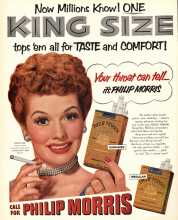I’ve been watching a lot of Mad Men, and on the show, one of the ad men’s most persistent tasks has been making cigarette smoking seem innocuous. You know that everyone understood that putting a burning stick into their mouths was probably not great for their health long before the Surgeon General started issuing those nasty warnings on the packages. In fact, one of the most common ads for cigarettes were statements from doctors saying that they also smoked Lucky Strikes or Camels, and they were doing just fine.
Stanford School of Medicine publicized their research on the history of tobacco advertising online. The School has a specific taskforce called the Stanford Research on the Impact of Tobacco Marketing, and included faculty and students from a number of different departments who considered the impact of cigarette marketing on consumers throughout the decades.
The website tracks a number of popular slogans from some popular brands. Many of them make mention that that particular brand of cigarette will not irritate the throat or the lip. For example, Lucky Strike used the slogan "Toasting removes dangerous irritants that cause throat irritation and coughing” to advertise their product. Weirder still is some slogans which advertise cigarettes as cure-alls. A slogan for a Menthol cigarette brand called Spuds states “"Nose or throat congested? Its time to change to Spuds."
The website also includes television and print advertisements that span decades. Stanford divides the print advertising into searchable databases based on the lead personality. Movie and television stars were popular in cigarette advertisements, but so were—unbelievable opera and Broadway singers, who most definitely couldn’t have smoked too frequently. For example, Lucille Ball starred in an ad for Philip Morris with the slogan “Your throat can tell…it’s Philip Morris.” The cigarette company also sponsored her show.
The website also includes a YouTube link to some seriously fascinating commercial and television advertising videos. Again, these are divided by the lead in the commercials, including athletes, doctors and animated characters. It’s not difficult to understand to whom a 1960’s cigarette commercial featuring Fred Flintstone buying Winston cigarettes is geared. Also featured are famous macho Marlboro commercials, which include the Marlboro cowboys, who smoke cigarettes after a hard day’s work.
The website is a reminder that we’re probably still jeopardizing our health in some way because of some snazzy ad campaign. What do you think about tobacco advertising? Do you think that tobacco advertisement guidelines has limited its popularity?
